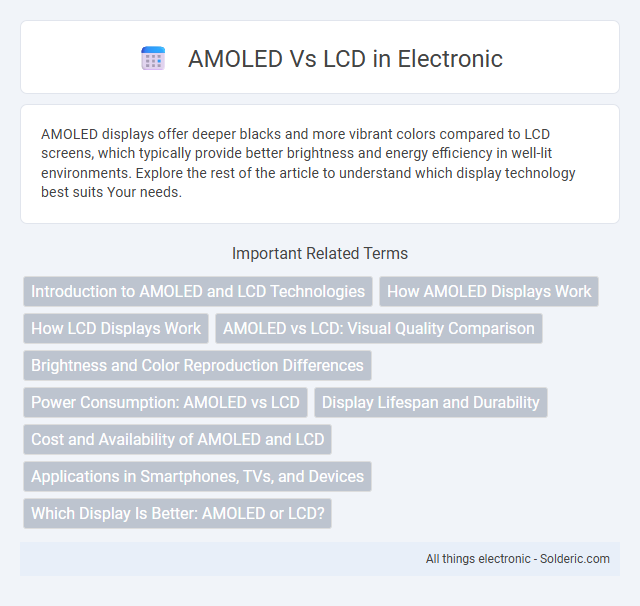AMOLED displays offer deeper blacks and more vibrant colors compared to LCD screens, which typically provide better brightness and energy efficiency in well-lit environments. Explore the rest of the article to understand which display technology best suits Your needs.
Comparison Table
| Feature | AMOLED | LCD |
|---|---|---|
| Display Technology | Active Matrix Organic Light Emitting Diode | Liquid Crystal Display |
| Brightness | High, but can be less bright in direct sunlight | Generally brighter, better visibility under sunlight |
| Color Accuracy | Vivid, high contrast, deep blacks | Less contrast, colors can look washed out |
| Black Levels | True black (pixels turn off) | Backlight always on, blacks appear grayish |
| Power Consumption | More efficient with dark themes | Consumes consistent power regardless of content |
| Viewing Angles | Wide viewing angles with minimal distortion | Good, but colors shift at extreme angles |
| Thickness & Flexibility | Thinner and flexible, ideal for curved screens | Thicker and rigid |
| Lifespan | Potential burn-in, shorter lifespan | Longer lifespan, no burn-in issues |
| Cost | Generally more expensive | More affordable |
Introduction to AMOLED and LCD Technologies
AMOLED technology uses organic light-emitting diodes to produce vibrant colors and deep blacks by independently lighting each pixel, enhancing contrast and energy efficiency. LCD screens rely on a backlight that passes through liquid crystals and color filters, offering consistent brightness but less contrast compared to AMOLED displays. Your choice between AMOLED and LCD impacts visual experience, device battery life, and screen durability.
How AMOLED Displays Work
AMOLED displays work by using organic compounds that emit light when an electric current passes through them, allowing each pixel to generate its own light independently. This self-emissive technology enables deeper blacks and higher contrast ratios compared to LCDs, which rely on backlighting. The ability to control each pixel's illumination individually results in more vibrant colors and improved energy efficiency, especially in dark scenes.
How LCD Displays Work
LCD displays work by using a backlight that passes through multiple layers, including liquid crystal cells, which modulate light based on electrical signals to create images. The liquid crystals align to block or allow light to pass through color filters, producing pixels in red, green, and blue. This technology relies on constant backlighting, affecting contrast and energy efficiency compared to AMOLED displays.
AMOLED vs LCD: Visual Quality Comparison
AMOLED displays offer superior visual quality with deeper blacks and higher contrast ratios due to their self-emissive pixels, while LCD screens rely on backlighting, resulting in less vibrant colors and lower contrast. AMOLED panels provide faster response times and better viewing angles, enhancing overall image sharpness and color accuracy compared to LCD technology. However, LCD displays generally produce brighter images in direct sunlight, maintaining visibility where AMOLED brightness may diminish.
Brightness and Color Reproduction Differences
AMOLED displays offer superior color reproduction with deeper blacks and higher contrast ratios due to individually lit pixels, resulting in more vibrant and true-to-life images compared to LCDs. LCD screens generally achieve higher peak brightness levels, making them more visible in direct sunlight, but their backlight can cause color washout and reduced contrast. Your choice depends on whether you prioritize vivid colors and deeper blacks or enhanced brightness for outdoor viewing.
Power Consumption: AMOLED vs LCD
AMOLED displays consume less power than LCDs when displaying dark or black images because each pixel emits its own light and can be turned off individually, reducing energy usage. Conversely, LCDs require a constant backlight, leading to higher power consumption regardless of the image content. Your device's battery life benefits more from AMOLED technology, especially with darker themes or content.
Display Lifespan and Durability
AMOLED displays generally have a shorter lifespan compared to LCDs due to organic material degradation, often lasting around 20,000 to 30,000 hours before brightness significantly diminishes. LCD screens benefit from longer durability and less susceptibility to screen burn-in, making them more reliable over extended periods. Your choice between AMOLED and LCD should consider whether vibrant colors or prolonged lifespan is a higher priority for your usage.
Cost and Availability of AMOLED and LCD
AMOLED displays generally cost more to produce than LCDs due to advanced technology and manufacturing complexity, affecting device pricing. LCD screens dominate the market with widespread availability, making them a more budget-friendly option for many consumers. Your choice between AMOLED and LCD often depends on balancing cost with desired display quality and availability.
Applications in Smartphones, TVs, and Devices
AMOLED displays dominate high-end smartphones due to their superior contrast ratios, deeper blacks, and energy efficiency compared to LCDs. In TVs, LCD technology remains prevalent for cost-effective large screens, while AMOLED is increasingly used in premium models offering vibrant colors and better viewing angles. Wearable devices prefer AMOLED for flexible designs and lower power consumption, enhancing battery life and user experience.
Which Display Is Better: AMOLED or LCD?
AMOLED displays offer deeper blacks, higher contrast ratios, and more vibrant colors compared to LCD screens, making them ideal for media consumption and gaming. LCD panels, however, provide better brightness levels and color accuracy in well-lit environments, often resulting in longer battery life for devices. Choosing the better display depends on usage preferences, with AMOLED preferred for vivid visuals and LCD for consistent performance in bright conditions.
AMOLED vs LCD Infographic

 solderic.com
solderic.com